ACD Museum is home to oldest Auburn
Read more about the museum’s 1904 Auburn B — the oldest surviving car of the maker.
During their annual Labor Day pilgrimage to Auburn, Ind., Auburn, Cord and Duesenberg fans stop by 1600 Wayne St. to pay homage to the city's namesake marque. Inside the hallowed walls of the Auburn Cord Duesenberg Museum are a myriad of gleaming Classics, bearing not only the Auburn badge, and those of the prestigious sister companies Cord and Duesenberg, but also their competitors.
In their rush to see the spectacular Duesenbergs, Cords and Auburns of the 1930s that fill much of the ACD Museum, many visitors exit the elevator and walk past this car, scarcely giving it a glance. However, all the Classics listed above can trace their roots to this vehicle ' the 1904 Auburn B ' the oldest surviving car of the maker.
Overlooked by many is a diminutive blue car of great historic stature. As one exits the elevator to the third floor, you are confronted with an early Auburn wearing a striking blue-and-cream paint scheme. This Model B is the oldest Auburn existent. The rear-entrance tonneau rolled out of Frank and Morris Eckhart's shop in 1904 under the power of a 196-cid, two-cylinder, opposed engine. The 18 horsepower plant, with 5-inch bore and 5-inch stroke, is mounted under the body amidships, with the hood area being occupied by the fuel tank and radiator.
Typical of automobiles of this era ' and of the Eckharts' father's carriages ' the Model B features extensive use of fine woodwork and brass. Just visible on the floorboard of the car is the 1986 AACA National First Prize medallion.
This car has been in the museum since 1981, when it was donated by Thomas Lester. Restoration of the car consumed most of five years, being finished in 1986 by Paul Freehill of Stutz Specialty in nearby Fort Wayne just in time for the Antique Automobile Club of America fall meet in Hershey, Pa. At that show, the car received first-place honors in its class, and was also selected as a recipient of a National Award by the AACA.
With chain drive and an original cost of $1,200, the 1904 Auburn stands in marked contrast to the sleek, front-wheel-drive Cords and powerful Duesenbergs that were designed in the building the Model B now calls home. However, the workmanship that would become a hallmark of these brands is evident in the black pebble-grain leather upholstery and carefully placed rear step of the Model B. Innovative design, later typified by hidden headlamps and turbochargers, was evident, as well, in the 1904 model in the form of a swing-away steering wheel and an overhead-valve engine.
The Model B has a 92-inch wheelbase, and, as one would expect, rides on natural rubber balloon tires. The gold pinstriping accentuates the lines of Frank and Morris Eckhart's creation.
The Auburn name is also cast into the engine, which is mounted beneath the passenger compartment. When the Eckhart brothers decided to enter the automobile business, they began by purchasing a Cadillac and disassembling it. They then sought to improve on the car in every area, including the engine.
At the rear of the Model B are full elliptical springs. Semi-elliptical units are used at the front. The large sprocket on the rear axle, driven by roller chain, is visible here as well.
The low-mounted engine is even visible when the car is viewed from the front. No doubt this exposed position and complex piping posed maintenance issues, given the crude roads found in 1904.
Because of the rear-entrance tonneau design, the Model B can seat five ' albeit small ' passengers. Kerosene-fired side lamps are fitted to the car, while the headlamps are acetylene fueled.








